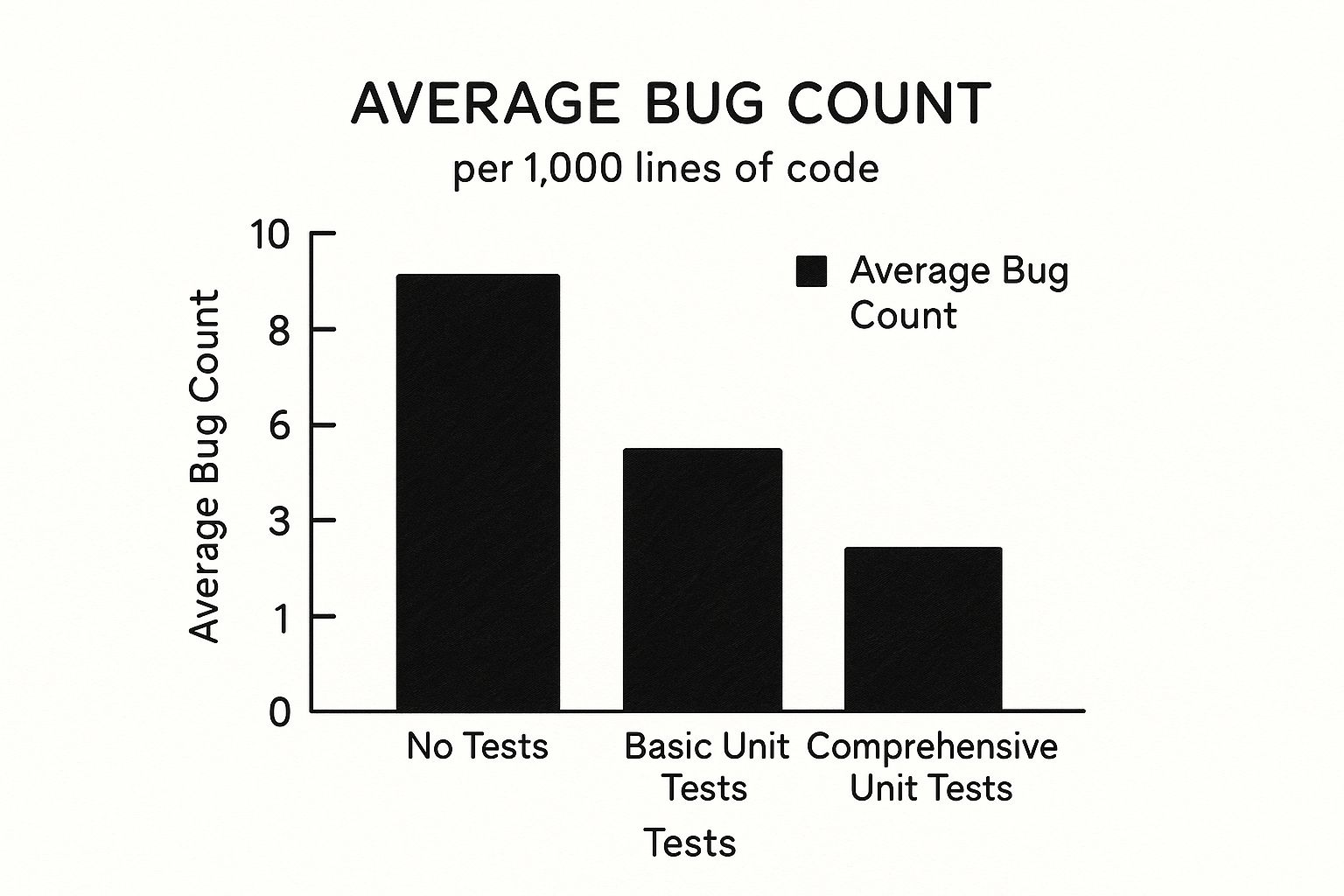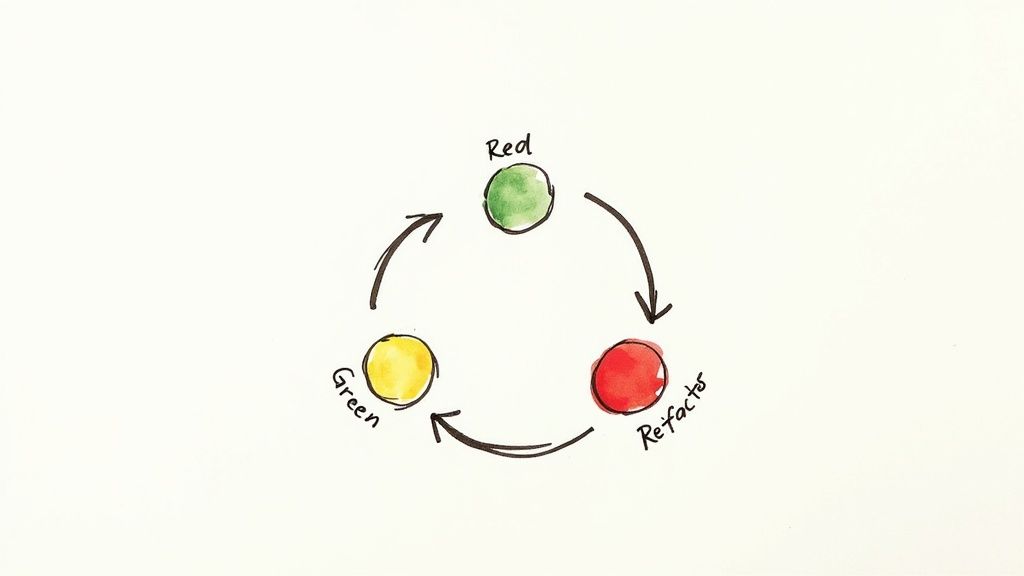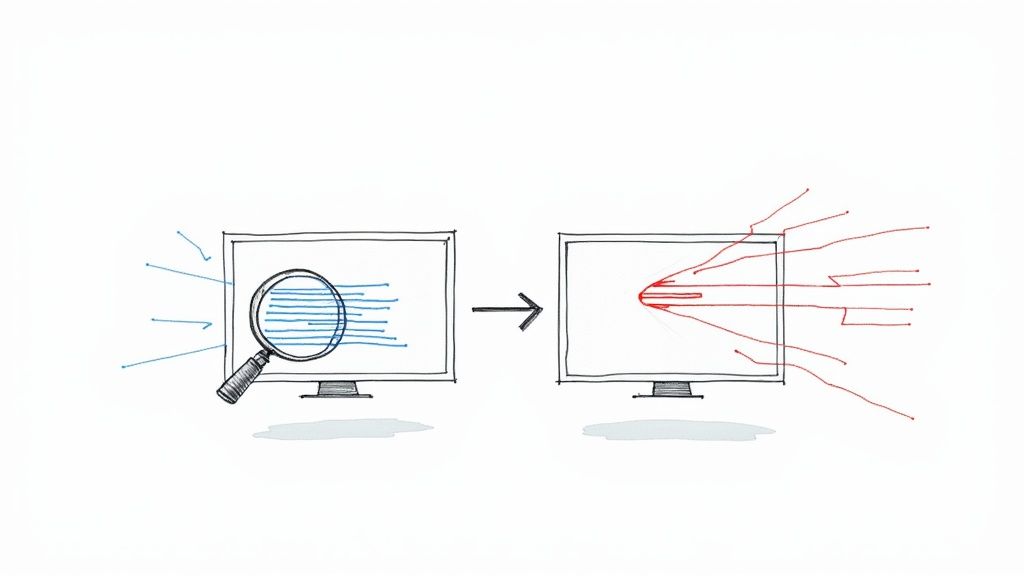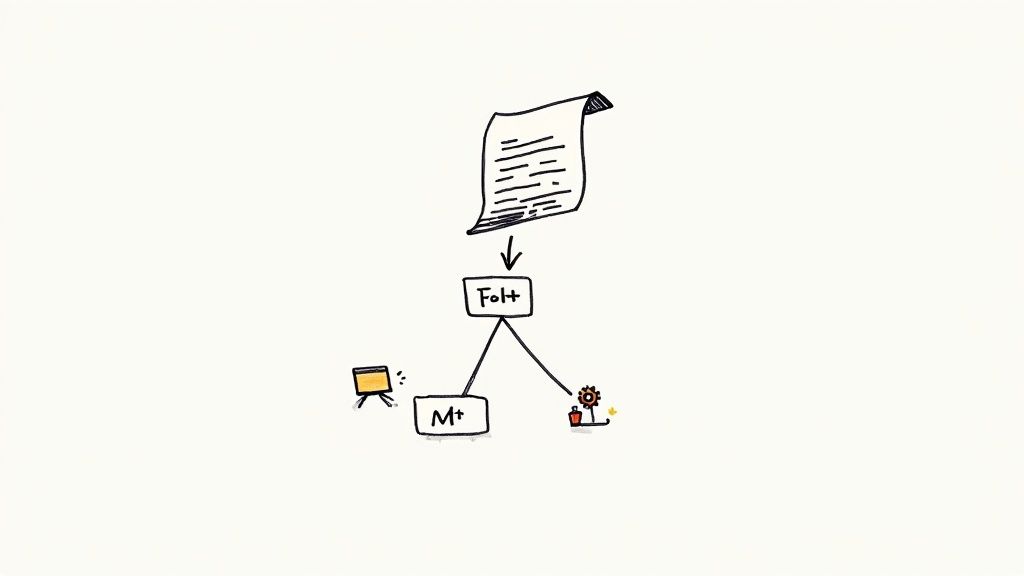Unit Tests for JavaScript: Boost Your Code Confidence

Why Your JavaScript Code Desperately Needs Unit Testing
Let's be real for a second. Shipping code without a safety net feels like a high-stakes gamble. You push to production, hold your breath, and just hope the pager stays quiet. I’ve been there, and I know many developers who have learned the hard way that hope is not a strategy. The real secret weapon for confident deployment isn't luck; it's a solid suite of unit tests for JavaScript.
From Bug-Hunting to Confident Shipping
Without tests, the development cycle can quickly turn into a chaotic loop of fixing bugs. A small change in one file can unknowingly break a feature somewhere else entirely. This reactive, bug-hunting approach isn't just inefficient; it's a huge source of stress for development teams. I’ve seen firsthand how teams transform their workflow from anxious deployment cycles to confident releases just by embracing unit testing.
The change is profound. Instead of manually checking if the login form still works after tweaking a utility function, you just run your tests. This automated verification catches regressions instantly, giving you immediate feedback. It lets developers refactor and improve code with confidence, knowing that a green checkmark means the core logic is still solid.
The Hidden Costs of Skipping Tests
The price of not writing tests goes far beyond the time spent fixing bugs. It wears down team morale and, in the worst-case scenario, damages client trust. When production is constantly breaking, the blame game starts, and team dynamics suffer. Plus, delivering a buggy product can make clients question your team's competence and reliability. The real cost isn't just developer hours; it’s the reputation of your entire team and product.
Embracing unit tests for JavaScript is a proactive investment in quality and stability. The data supports this. Statistical insights from a survey of 10,000 developers revealed that 74% saw significant improvements in code reliability after implementing systematic unit testing. Furthermore, 68% reported fewer bugs in production, directly linking these gains to their testing practices. You can review the full research on unit testing gains to learn more about these findings and how teams benefit from writing tests.
Ultimately, writing unit tests fundamentally changes your mindset. You start thinking more critically about your code's design, making it more modular and decoupled so it’s easier to test. This leads to not just more reliable code, but better-architected code. Tests become a form of living documentation, clearly defining what each piece of code is supposed to do, which is invaluable for both current and future developers on your team.
Picking the Perfect Testing Framework Without the Overwhelm
Diving into the world of unit tests for JavaScript can feel like stepping into a crowded marketplace. With names like Jest, Mocha, and Cypress all vying for your attention, it’s easy to get stuck in "framework paralysis." But the trick is to cut through the marketing noise and figure out what truly matters for your project and your team.
Making this choice is a big deal. The framework you select will influence everything from your day-to-day workflow and how you onboard new developers to how quickly you can track down and fix bugs. It’s not just about a list of features; it’s about long-term maintainability and creating a positive developer experience.
Aligning Your Choice with Your Project's Needs
There's no magic, one-size-fits-all answer here. A team building a complex React application will have very different priorities than a team maintaining a small Node.js library. The common trade-off is usually between how easy it is to get started versus how much flexibility you have down the road. Some frameworks are all-in-one solutions, while others are more modular, letting you piece together your ideal testing stack.
As JavaScript continues to be one of the most widely used programming languages, its testing ecosystem has matured quite a bit. To help you sort through the options, I've put together a comparison table of the most popular frameworks.
JavaScript Testing Framework Comparison
A detailed comparison of popular JavaScript testing frameworks including features, learning curve, and ideal use cases
| Framework | Learning Curve | Best For | Key Features | Community Support |
|---|---|---|---|---|
| Jest | Low | React apps, "zero-config" setups, beginners | All-in-one, snapshot testing, parallel test execution, mocking built-in | Very Strong |
| Mocha | Medium | Flexible, customizable testing environments | Highly extensible, runs in Node.js & browser, asynchronous support | Strong |
| Cypress | Low to Medium | End-to-end (E2E) testing, real browser interactions | Time-travel debugging, real-time reloads, automatic waiting, video recording | Strong & Growing |
| Jasmine | Low | Behavior-Driven Development (BDD), Angular projects | "Batteries-included," clean syntax, no external dependencies | Moderate |
Jest, for example, is often praised for its "zero-config" approach and tight integration with React, which has made it a dominant force in the community. On the other hand, Mocha’s flexibility might be a better fit if your project has some unique requirements that demand a more tailored setup. You can discover more insights about these JavaScript frameworks to compare their features in greater detail.
The impact of this decision is hard to overstate. Just look at how rigorous testing affects code quality.

The data here is clear: moving from no tests to even basic unit testing can cut the bug count in half. When you implement a full suite of tests, that number drops by a massive 80%.
Factors Beyond the Feature List
When you're weighing your options, it's important to look beyond a simple feature checklist. Here are a few practical things I always consider:
- Community and Documentation: Is the community active? When you get stuck, can you easily find answers on Stack Overflow or GitHub? Clear, well-maintained documentation is an absolute lifesaver.
- Team Experience: What are your developers already familiar with? Leaning into existing knowledge can seriously speed up adoption and cut down on the initial learning curve.
- Ecosystem Integration: How well does the framework play with the other tools in your stack? Think about your UI library, CI/CD provider, or bundler. A smooth integration prevents a lot of maintenance headaches later on.
Choosing thoughtfully at this stage saves you from painful and costly migrations in the future. More importantly, it sets your team up for a more confident and efficient development process where testing is a help, not a hindrance.
Building Your Testing Environment the Right Way

A solid testing environment is the bedrock of effective unit tests for JavaScript. This isn't just about picking a framework and running an install command. It's about designing a setup that grows with your project instead of becoming a maintenance bottleneck. A little foresight here will save you major headaches six months from now when your codebase has doubled in size.
Structuring Your Project for Testability
First, let's talk about where your tests should live. I'm a big fan of co-location, a practice where you place test files right next to the source files they're testing. From my experience, this simple choice has a few powerful benefits:
- Discoverability: It's instantly clear what code is tested and what isn't. When a developer opens a component folder, they'll see
MyComponent.jsandMyComponent.test.jssitting side-by-side. No more hunting around a separatetestsdirectory. - Maintenance: When you refactor or delete a component, you're much more likely to remember to update or remove its test file because it's in the same place. Out of sight, out of mind doesn't work well for test suites.
- Import Paths: It keeps import paths in your tests short and clean, which makes them less likely to break when you move files around.
Here’s what this looks like in a real project structure: /src /components /Button - Button.js - Button.test.js - styles.css /utils - format-date.js - format-date.test.js This approach bundles everything related to a single unit together. It’s a small organizational habit that brings a ton of clarity and order to your project.
Essential Configuration and Best Practices
With your folders organized, your next job is to dial in the configuration. Every framework has a config file (like jest.config.js for Jest), but one of the most important things you can do is define a dedicated test script in your package.json. This creates a standard way for anyone on your team, and your CI/CD pipeline, to run tests.
For instance, you can set up scripts like these: "scripts": { "test": "jest", "test:watch": "jest --watch", "test:coverage": "jest --coverage" } This simple setup provides consistency. Anyone on the team can run npm test and get the exact same result. Adding scripts for watching files during development (test:watch) or generating coverage reports (test:coverage) also makes everyday tasks much smoother.
To keep your tests predictable and isolated, you should rely on mocks for any external dependencies, such as APIs or databases. As highlighted in a great guide to Node.js unit testing, mocking stops your unit tests from failing because of things outside your control, like a network outage. This ensures your tests are genuinely checking your unit's logic, not the stability of a third-party service. Getting this foundation right from the start is what makes your testing efforts sustainable and truly valuable.
Writing Unit Tests That Actually Catch Bugs

Once your testing environment is up and running, it's time to get down to business and write tests that do more than just pass. The real goal is to create unit tests for JavaScript that serve as a reliable safety net, catching those tricky bugs that often escape code reviews. This means shifting your focus from how your code works to what it actually does.
The history of JavaScript testing provides a great roadmap here, especially with the rise of component-based frameworks like React. The introduction of the React Testing Library was a game-changer. It championed a philosophy of testing based on user interactions and observable outcomes, not internal implementation. When you pair this approach with a powerful tool like Jest, you get a combination that has become a modern standard. You can dig deeper into how Jest remains a cornerstone of modern testing. The key takeaway is simple: write tests that stay relevant even when you refactor the code behind them.
The Anatomy of a Valuable Test
A truly useful unit test tells a clear story with a beginning, a middle, and an end. This structure is famously known as the "Arrange, Act, Assert" pattern, and it’s a brilliant mental model for keeping your tests clean and understandable.
- Arrange: This is your setup phase. You gather all the ingredients your code needs to run. That might mean creating mock data, rendering a component with specific props, or setting up a fake function call.
- Act: Here, you perform the main event. You call the function or trigger the user interaction you want to test. Ideally, this should be a single, focused action.
- Assert: Finally, you check the results. Did the function return the value you expected? Did the component display the correct text after the action?
Imagine you're testing a function that calculates a shopping cart total. First, you'd arrange an array of products, each with a price. Then, you'd act by calling your calculateTotal function with that array. To finish, you'd assert that the function's return value is the correct sum. Sticking to this pattern makes your tests incredibly readable and a breeze to debug when they fail.
Testing Beyond the Happy Path
The most insightful tests are the ones that explore the messy, unexpected scenarios—the edge cases and "unhappy paths." What happens when your function gets null instead of an array? Or an empty string? These are the dark corners where bugs thrive.
When writing unit tests for JavaScript, always push the boundaries by asking:
- What happens if I pass in invalid inputs (e.g., wrong data types,
undefined)? - How does my code handle empty arrays or objects?
- What about extreme values, like massive numbers, negative numbers, or zero?
Probing these conditions does more than just find bugs; it forces you to build more robust and resilient code from the start. These tests become a form of living documentation, clearly demonstrating to other developers how a piece of code is designed to behave in all sorts of situations. If you're looking for more ways to strengthen your testing, our guide on unit testing best practices offers some great additional tips.
Mastering Advanced Testing Techniques That Pros Use

Writing basic unit tests for JavaScript is a fantastic start, but to build a truly resilient application, you have to dig deeper. Professional developers lean on a collection of advanced techniques to manage the messy, real-world complexity of modern software. This is the point where you graduate from simple function checks and begin to isolate your code from the unpredictable nature of external services, APIs, and databases.
One of the most powerful tools in your testing toolkit is mocking. Imagine your code relies on an external API. You don't want your tests to fail just because that API is down or responding slowly. By creating a mock—a stand-in version of that dependency—you gain complete control over its behavior. This allows you to test how your code handles a successful API response, a network error, or an empty data set, all without a single real network call. This practice is essential for building fast, reliable, and isolated tests that only break when your code has a problem.
From Simple Checks to Sophisticated Scenarios
Beyond just mocking, seasoned developers adopt patterns that make their code more testable from the ground up. Dependency Injection (DI) is a key example. Instead of having a function create its own dependencies (like an API client or a logger), you pass those dependencies in as arguments. This might seem like a small design choice, but it's a huge win for testing because you can easily swap the real dependency with a mock during your tests.
This approach works especially well with a methodology like Test-Driven Development (TDD), where writing the test first naturally pushes you to design more decoupled and testable code from the very beginning.
To help you choose the right technique for the right job, here’s a quick guide that breaks down the most common approaches.
Testing Techniques and When to Use Them
A comprehensive guide to different testing techniques, their applications, and complexity levels
| Technique | Use Case | Complexity | Benefits | Common Pitfalls |
|---|---|---|---|---|
| Mocking | Isolating code from external APIs or complex dependencies. | Medium | Fast, reliable tests that run in isolation. | Over-mocking, which can hide integration issues. |
| Stubbing | Forcing a function to return a specific value for a test. | Low | Simple way to control test conditions and paths. | Can make tests brittle if implementation changes. |
| Dependency Injection | Making components easier to test by providing dependencies. | Medium | Creates highly testable, decoupled, and reusable code. | Can add boilerplate and complexity if overused. |
| Parameterized Tests | Running the same test logic with multiple different inputs. | Low | Reduces code duplication and covers more edge cases. | Test failures can be harder to debug if not named well. |
Understanding these different methods is what elevates a fragile test suite to a robust one. By intentionally designing for testability and using mocks and stubs to control the test environment, you create a powerful safety net. This allows you to refactor code and introduce new features with the confidence that your unit tests for JavaScript are genuinely protecting your application's core logic.
Making Tests Part of Your Deployment Pipeline
Having a stellar collection of unit tests for your JavaScript project is a great start, but their true value shines when they run automatically and consistently. Tests that only exist on a developer's machine are easily forgotten or skipped. To genuinely protect your code quality, you need to plug them into your Continuous Integration (CI) pipeline. Think of it as an automated gatekeeper that guards your production environment.
This step shifts testing from a manual task into a smooth, integrated part of your development workflow. By automating this process, you ensure every single change is checked before it has a chance to cause problems. This proactive approach helps you find bugs early, long before they can impact your users.
Configuring Your CI for Automated Testing
Integrating your tests is pretty straightforward with modern platforms like GitHub Actions, GitLab CI/CD, or CircleCI. The main idea is to create a workflow file, usually in YAML format, that instructs the CI server on what to do. At a minimum, this process includes:
- Checking out the latest code from your repository.
- Installing all the project dependencies (e.g.,
npm install). - Running your dedicated test script (e.g.,
npm test).
Here’s a simple example of what a GitHub Actions workflow might look like. This configuration automatically runs your tests whenever a new pull request is opened.
This visual shows the CI pipeline as a series of automated jobs. If the "test" job fails, it blocks the "deploy" job from ever starting. This is the essence of a quality gate—a checkpoint that code must pass to move forward, effectively stopping broken code in its tracks.
Creating an Effective Feedback Loop
A solid CI integration does more than just run tests; it delivers fast, clear feedback. If a test fails, the system should immediately notify the right people, most often by marking the pull request as failed. This creates a tight feedback loop, allowing developers to jump on issues while the code is still fresh in their minds. For bigger projects, you can even explore parallel test execution, which splits your test suite across multiple virtual machines to drastically shorten run times.
The goal is to make test failures a high-priority, non-negotiable event. This fosters a culture where quality becomes a shared responsibility for the entire team. Writing tests is just one piece of the puzzle; ensuring they are well-defined and cover meaningful scenarios is just as crucial. To get this right, you might find our complete guide on how to write effective test cases helpful for making sure your CI pipeline is validating important logic. Ultimately, a well-tuned pipeline gives your team the confidence to merge and deploy code quickly without sacrificing stability.
Keeping Your Test Suite Healthy as Your Project Grows
Launching a project with a full suite of unit tests for JavaScript feels great, but the real test comes six months later. As your codebase expands and features evolve, your test suite can quietly transform from a helpful safety net into a brittle, slow, and frustrating burden. This is a common form of technical debt that many teams don't see coming until it's already slowing them down.
Evolving Tests Without the Pain
The key to long-term success is treating your test code with the same respect as your production code. When a feature changes, its corresponding tests must be updated in the same pull request. A test suite that falls out of sync with the application is worse than no tests at all because it creates a false sense of security.
One of the biggest challenges I've seen on large projects is test flakiness—intermittent failures that erode team confidence. These often stem from poorly managed test data or race conditions in asynchronous tests. Establishing clear team practices is crucial for combating this:
- Isolate Test Data: Each test should set up and tear down its own data. Never let tests rely on a shared, mutable state.
- Deterministic Mocks: Mocks for external services should always return predictable responses, eliminating network or API latency as a source of failure.
- Timeouts and Retries are a Red Flag: Using long timeouts or automatic retries often masks underlying problems in your code or test design. Address the root cause instead.
Knowing When a Test Is No Longer Valuable
Not all tests are created equal, and some outlive their usefulness. A test becomes a liability when the effort to maintain it outweighs the value it provides. This often happens with overly complex "snapshot tests" that break with minor UI tweaks or tests that are too tightly coupled to implementation details.
Regularly review your slowest and most failure-prone tests. Ask your team: "What bug is this test actually preventing?" If nobody can give a clear answer, it might be time to refactor it into something more focused or remove it entirely. The goal isn’t 100% coverage; it's meaningful coverage that empowers developers to ship code with confidence.
Maintaining a healthy test suite is a continuous process of refinement and discipline. By creating a culture where testing excellence is a shared responsibility, you ensure your unit tests for JavaScript remain a valuable asset, not a costly liability.
A great way to maintain this health is by automating your pull request management. Mergify’s Merge Queue can automatically batch and test your PRs, ensuring your main branch stays green and your CI costs stay low. Discover how Mergify can streamline your workflow.





